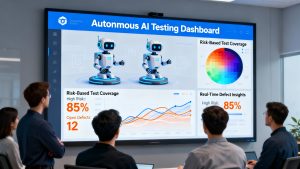Many diners reading restaurant menus are left wondering what a dish truly looks like, since most menus skip photos and food delivery apps often display generic images. Addressing this gap, one developer built an AI-based prototype able to visualize any written menu item in just a weekend. The goal: instantly generate realistic food images from dish descriptions, making dining choices easier and menu management more engaging for restaurants and food tech startups alike.
The Concept Behind Instant Food Visuals
The project envisions a frictionless flow where a user provides a text prompt such as “Grilled salmon with mango salsa and jasmine rice,” and the system returns a professional, mouth-watering image of the dish. This solution delivers value to restaurants that lack design resources, travelers facing foreign menus, and fast-moving food startups in need of quick visuals for prototyping or marketing.
Framework and Technology Stack
The solution leans on a modern full-stack approach, focusing on both usability and agility.
Frontend Stack:
- Lovable.dev: For rapid landing page creation and copywriting
- React (TypeScript): Building a responsive user interface
- Vite: For blazing-fast development and optimized builds
- Tesseract.js: Client-side optical character recognition (OCR) for extracting text from images
- Axios: Streamlined HTTP requests
- Tailwind CSS: Utility-first styles for quick visual iteration
Backend Stack:
- Python Flask: Lightweight API server
- OpenAI API: For intelligent extraction and structuring of dish names and descriptions
- Replicate API: Advanced image synthesis (Stable Diffusion, 512×512 resolution)
- Flask-CORS: Secure cross-origin resource sharing for web clients
Crafting the Landing Page in Minutes
A professional landing page was created in less than 15 minutes by generating marketing copy on Lovable.dev and integrating it into a simple Carrd template. This process allowed quick deployment and showcased the service’s capabilities—inviting users to “visualize your dishes before they hit the table.”
From Menu to Realistic Images: The Three-Step Process
The heart of the prototype is a streamlined three-stage pipeline:
- Text Extraction from Images
- Users upload photos of menus or dish names.
- Tesseract.js runs in-browser OCR, pulling raw text instantly from images.
const { createWorker } = require("tesseract.js"); const extractText = async (imagePath) => { const worker = await createWorker("eng"); const { data: { text } } = await worker.recognize(imagePath); await worker.terminate(); return text; }; - Structuring Menu Information with OpenAI
- The extracted text is sent to OpenAI’s API, where GPT interprets and organizes menu items as JSON.
- This process transforms messy, unformatted OCR output into clean data—capturing both dish names and appetizing descriptions.
[ { "name": "Lobster Thermidor Crumpet", "description": "Delicious lobster on a crumpet with a refreshing pink grapefruit salad" } ]Prompt-engineered requests ensure that only food menu content gets processed. - Photorealistic Image Generation
- Each dish’s data is relayed to Replicate’s Stable Diffusion model.
- Carefully engineered prompts instruct the model to generate “beautifully plated, professionally photographed dishes” on clean backgrounds.
const output = await replicate.run("stability-ai/sdxl:latest", { input: { prompt: "A photorealistic, beautifully plated, tasty-looking dish: {dish name}. {description} ... 4k, studio lighting." }, });
DevOps: Secure, Scalable, and Dockerized
The project’s architecture is designed for easy replication and security:
- All configuration secrets (API keys, endpoints) are managed through
.envfiles kept out of version control. - The entire stack is containerized using Docker, facilitating consistent deployment from laptops to the cloud.
- Clear separation between backend logic and frontend display enables independent deployment and scaling.
Deployment Pathways for Developers
Multiple hosting options provide flexibility for launching the MVP:
Frontend Deployment:
- Lovable.dev for ultra-fast, no-code hosting and simple environment variable management
- Vercel, Netlify, or Cloudflare Pages for robust React or static site deployments
- Always use environment variables (e.g.,
VITE_API_URL) to point the app to the backend or external APIs
Backend/API Deployment:
- Render and Railway for hosted Node.js, Flask, or Docker containers (both offer free tiers)
- Fly.io for global, low-latency Docker app hosting
- Supabase or Firebase Functions for serverless API endpoints
- Security best practice: expose the appropriate port in your Dockerfile and avoid hardcoding sensitive data
A Typical End-to-End Architecture
text[Frontend on Lovable/Vercel] ──> [Backend on Render/Railway/Replicate API]
↑
(env: VITE_API_URL=https://api.example.com)
What Was Achieved in a Weekend
In less than 48 hours, a fully functional MVP was brought to life. Users can upload menu photos or enter dish descriptions, and receive back custom, photorealistic images styled for menus or delivery apps. The prototype leverages state-of-the-art AI for both understanding food content and generating new visuals—without the need for a dedicated design team.
Key Takeaways for Innovators
- AI can power rapid MVPs that bring tangible value, not just content.
- Clear data pipelines and thoughtful prompt engineering are critical for reliability.
- Dockerization and environment-based configuration ensure portability and security.
- Modern tools can drastically shorten the time to product validation and launch.
Conclusion
By using today’s AI platforms and a modern software stack, it’s possible to dream up, build, and deploy creative, production-ready tools at unprecedented speed. Food startups, restaurants, and platforms can now offer diners realistic, mouth-watering images for any menu item in record time—bridging the gap between imagination and delicious reality.
Read more such articles from our Newsletter here.



